TPMS FIAT 124 SPIDER 2020 Owner handbook (in English)
[x] Cancel search | Manufacturer: FIAT, Model Year: 2020, Model line: 124 SPIDER, Model: FIAT 124 SPIDER 2020Pages: 228, PDF Size: 5.08 MB
Page 10 of 228
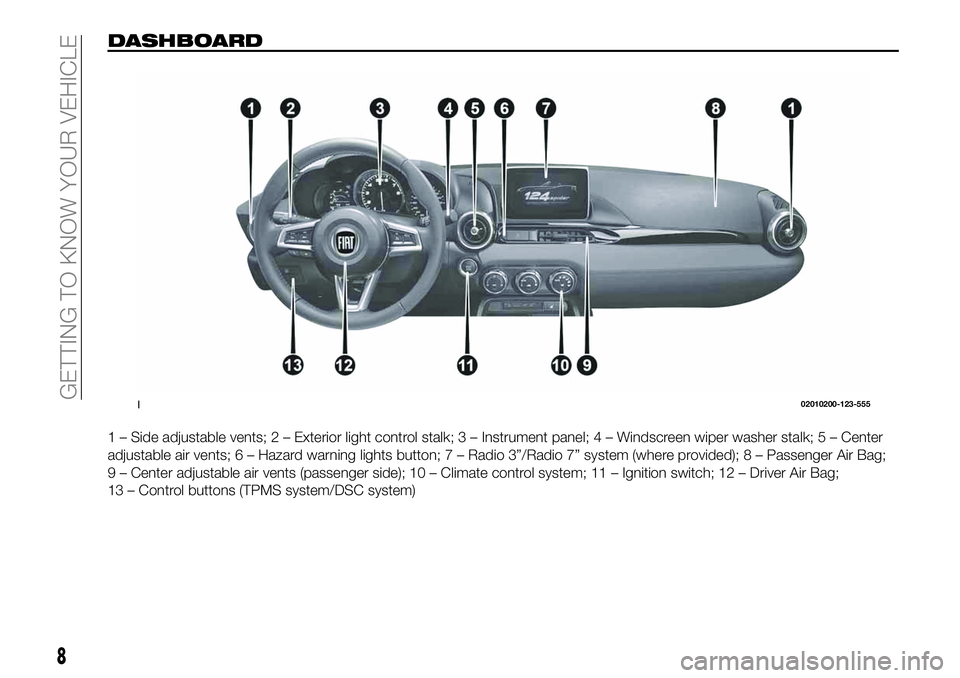
DASHBOARD
1 – Side adjustable vents; 2 – Exterior light control stalk; 3 – Instrument panel;4–Windscreen wiper washer stalk; 5 – Center
adjustable air vents; 6 – Hazard warning lights button; 7 – Radio 3”/Radio 7” system (where provided); 8 – Passenger Air Bag;
9 – Center adjustable air vents (passenger side); 10 – Climate control system; 11 – Ignition switch; 12 – Driver Air Bag;
13 – Control buttons (TPMS system/DSC system)
102010200-123-555
8
GETTING TO KNOW YOUR VEHICLE
Page 63 of 228
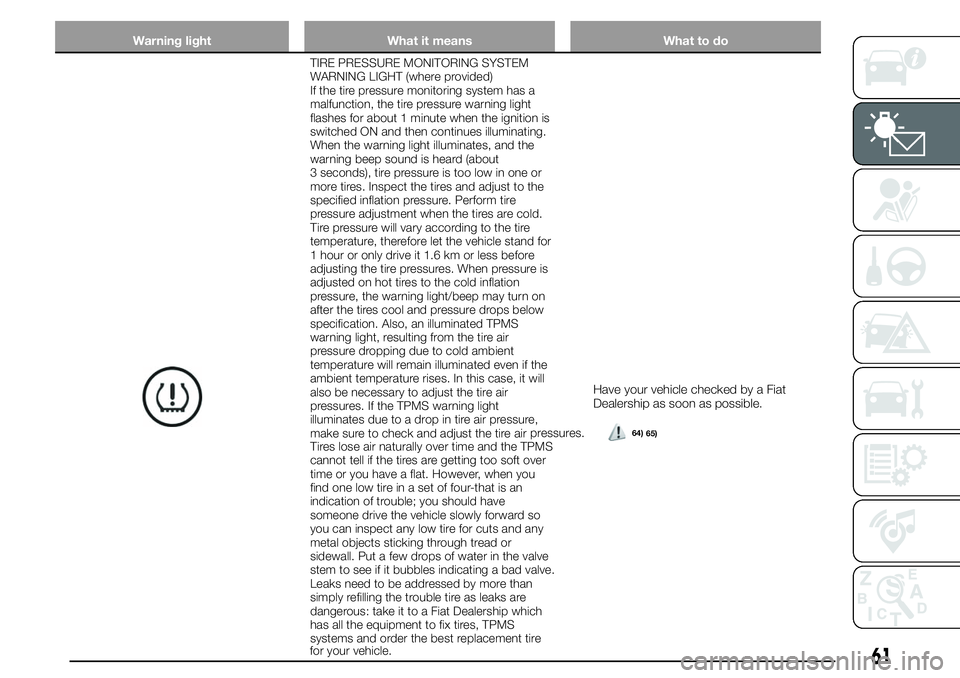
Warning light What it means What to do
TIRE PRESSURE MONITORING SYSTEM
WARNING LIGHT (where provided)
If the tire pressure monitoring system has a
malfunction, the tire pressure warning light
flashes for about 1 minute when the ignition is
switched ON and then continues illuminating.
When the warning light illuminates, and the
warning beep sound is heard (about
3 seconds), tire pressure is too low in one or
more tires. Inspect the tires and adjust to the
specified inflation pressure. Perform tire
pressure adjustment when the tires are cold.
Tire pressure will vary according to the tire
temperature, therefore let the vehicle stand for
1 hour or only drive it 1.6 km or less before
adjusting the tire pressures. When pressure is
adjusted on hot tires to the cold inflation
pressure, the warning light/beep may turn on
after the tires cool and pressure drops below
specification. Also, an illuminated TPMS
warning light, resulting from the tire air
pressure dropping due to cold ambient
temperature will remain illuminated even if the
ambient temperature rises. In this case, it will
also be necessary to adjust the tire air
pressures. If the TPMS warning light
illuminates due to a drop in tire air pressure,
make sure to check and adjust the tire airpressures.
Tires lose air naturally over time and the TPMS
cannot tell if the tires are getting too soft over
time or you have a flat. However, when you
find one low tire in a set of four-that is an
indication of trouble; you should have
someone drive the vehicle slowly forward so
you can inspect any low tire for cuts and any
metal objects sticking through tread or
sidewall. Put a few drops of water in the valve
stem to see if it bubbles indicating a bad valve.
Leaks need to be addressed by more than
simply refilling the trouble tire as leaks are
dangerous: take it to a Fiat Dealership which
has all the equipment to fix tires, TPMS
systems and order the best replacement tire
Have your vehicle checked by a Fiat
Dealership as soon as possible.
61for your vehicle.
64)
65)
Page 72 of 228
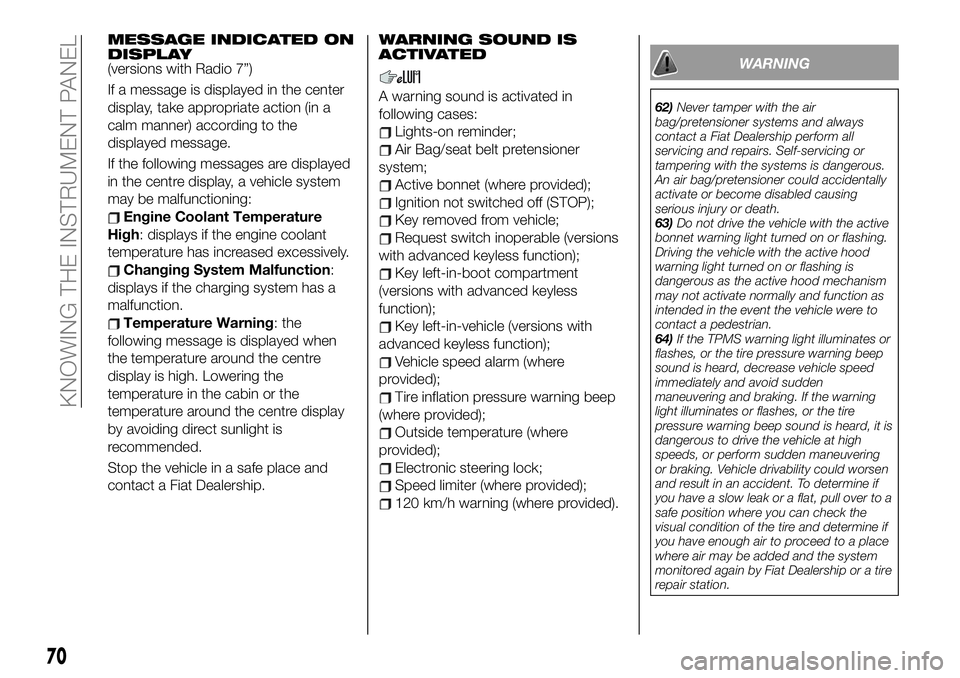
MESSAGE INDICATED ON
DISPLAY
(versions with Radio 7”)
If a message is displayed in the center
display, take appropriate action (in a
calm manner) according to the
displayed message.
If the following messages are displayed
in the centre display, a vehicle system
may be malfunctioning:
Engine Coolant Temperature
High: displays if the engine coolant
temperature has increased excessively.
Changing System Malfunction:
displays if the charging system has a
malfunction.
Temperature Warning: the
following message is displayed when
the temperature around the centre
display is high. Lowering the
temperature in the cabin or the
temperature around the centre display
by avoiding direct sunlight is
recommended.
Stop the vehicle in a safe place and
contact a Fiat Dealership.
WARNING SOUND IS
ACTIVATED
A warning sound is activated in
following cases:
Lights-on reminder;
Air Bag/seat belt pretensioner
system;
Active bonnet (where provided);
Ignition not switched off (STOP);
Key removed from vehicle;
Request switch inoperable (versions
with advanced keyless function);
Key left-in-boot compartment
(versions with advanced keyless
function);
Key left-in-vehicle (versions with
advanced keyless function);
Vehicle speed alarm (where
provided);
Tire inflation pressure warning beep
(where provided);
Outside temperature (where
provided);
Electronic steering lock;
Speed limiter (where provided);
120 km/h warning (where provided).
WARNING
62)Never tamper with the air
bag/pretensioner systems and always
contact a Fiat Dealership perform all
servicing and repairs. Self-servicing or
tampering with the systems is dangerous.
An air bag/pretensioner could accidentally
activate or become disabled causing
serious injury or death.
63)Do not drive the vehicle with the active
bonnet warning light turned on or flashing.
Driving the vehicle with the active hood
warning light turned on or flashing is
dangerous as the active hood mechanism
may not activate normally and function as
intended in the event the vehicle were to
contact a pedestrian.
64)If the TPMS warning light illuminates or
flashes, or the tire pressure warning beep
sound is heard, decrease vehicle speed
immediately and avoid sudden
maneuvering and braking. If the warning
light illuminates or flashes, or the tire
pressure warning beep sound is heard, it is
dangerous to drive the vehicle at high
speeds, or perform sudden maneuvering
or braking. Vehicle drivability could worsen
and result in an accident. To determine if
you have a slow leak or a flat, pull over to a
safe position where you can check the
visual condition of the tire and determine if
you have enough air to proceed to a place
where air may be added and the system
monitored again by Fiat Dealership or a tire
repair station.
70
KNOWING THE INSTRUMENT PANEL
Page 73 of 228
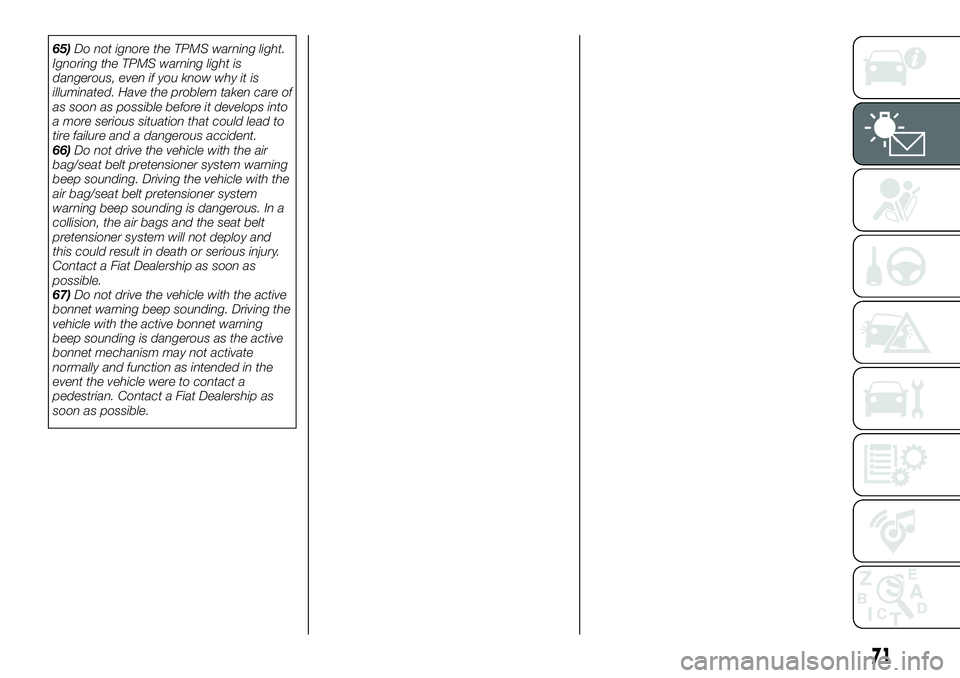
65)Do not ignore the TPMS warning light.
Ignoring the TPMS warning light is
dangerous, even if you know why it is
illuminated. Have the problem taken care of
as soon as possible before it develops into
a more serious situation that could lead to
tire failure and a dangerous accident.
66)Do not drive the vehicle with the air
bag/seat belt pretensioner system warning
beep sounding. Driving the vehicle with the
air bag/seat belt pretensioner system
warning beep sounding is dangerous. In a
collision, the air bags and the seat belt
pretensioner system will not deploy and
this could result in death or serious injury.
Contact a Fiat Dealership as soon as
possible.
67)Do not drive the vehicle with the active
bonnet warning beep sounding. Driving the
vehicle with the active bonnet warning
beep sounding is dangerous as the active
bonnet mechanism may not activate
normally and function as intended in the
event the vehicle were to contact a
pedestrian. Contact a Fiat Dealership as
soon as possible.
71
Page 79 of 228
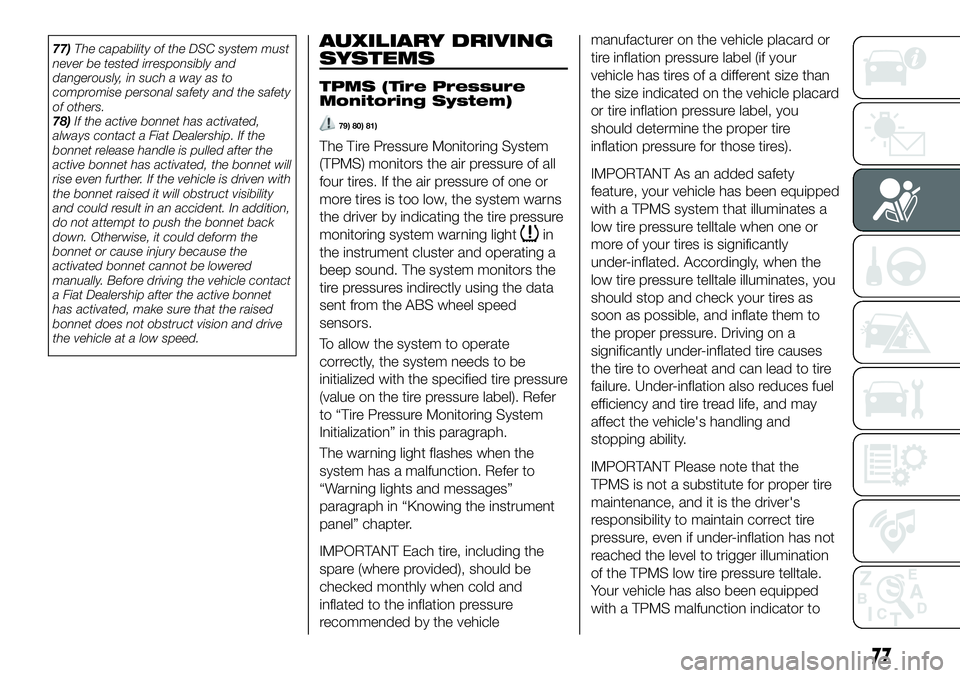
77)The capability of the DSC system must
never be tested irresponsibly and
dangerously, in such a way as to
compromise personal safety and the safety
of others.
78)If the active bonnet has activated,
always contact a Fiat Dealership. If the
bonnet release handle is pulled after the
active bonnet has activated, the bonnet will
rise even further. If the vehicle is driven with
the bonnet raised it will obstruct visibility
and could result in an accident. In addition,
do not attempt to push the bonnet back
down. Otherwise, it could deform the
bonnet or cause injury because the
activated bonnet cannot be lowered
manually. Before driving the vehicle contact
a Fiat Dealership after the active bonnet
has activated, make sure that the raised
bonnet does not obstruct vision and drive
the vehicle at a low speed.AUXILIARY DRIVING
SYSTEMS
TPMS (Tire Pressure
Monitoring System)
79) 80) 81)
The Tire Pressure Monitoring System
(TPMS) monitors the air pressure of all
four tires. If the air pressure of one or
more tires is too low, the system warns
the driver by indicating the tire pressure
monitoring system warning light
in
the instrument cluster and operating a
beep sound. The system monitors the
tire pressures indirectly using the data
sent from the ABS wheel speed
sensors.
To allow the system to operate
correctly, the system needs to be
initialized with the specified tire pressure
(value on the tire pressure label). Refer
to “Tire Pressure Monitoring System
Initialization” in this paragraph.
The warning light flashes when the
system has a malfunction. Refer to
“Warning lights and messages”
paragraph in “Knowing the instrument
panel” chapter.
IMPORTANT Each tire, including the
spare (where provided), should be
checked monthly when cold and
inflated to the inflation pressure
recommended by the vehiclemanufacturer on the vehicle placard or
tire inflation pressure label (if your
vehicle has tires of a different size than
the size indicated on the vehicle placard
or tire inflation pressure label, you
should determine the proper tire
inflation pressure for those tires).
IMPORTANT As an added safety
feature, your vehicle has been equipped
with a TPMS system that illuminates a
low tire pressure telltale when one or
more of your tires is significantly
under-inflated. Accordingly, when the
low tire pressure telltale illuminates, you
should stop and check your tires as
soon as possible, and inflate them to
the proper pressure. Driving on a
significantly under-inflated tire causes
the tire to overheat and can lead to tire
failure. Under-inflation also reduces fuel
efficiency and tire tread life, and may
affect the vehicle's handling and
stopping ability.
IMPORTANT Please note that the
TPMS is not a substitute for proper tire
maintenance, and it is the driver's
responsibility to maintain correct tire
pressure, even if under-inflation has not
reached the level to trigger illumination
of the TPMS low tire pressure telltale.
Your vehicle has also been equipped
with a TPMS malfunction indicator to
77
Page 80 of 228
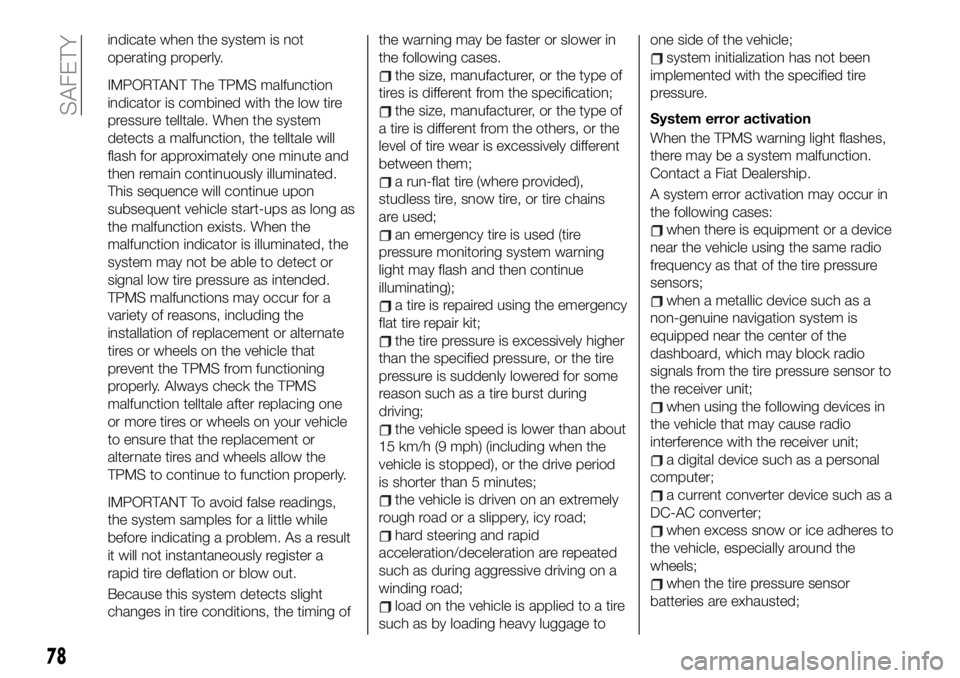
indicate when the system is not
operating properly.
IMPORTANT The TPMS malfunction
indicator is combined with the low tire
pressure telltale. When the system
detects a malfunction, the telltale will
flash for approximately one minute and
then remain continuously illuminated.
This sequence will continue upon
subsequent vehicle start-ups as long as
the malfunction exists. When the
malfunction indicator is illuminated, the
system may not be able to detect or
signal low tire pressure as intended.
TPMS malfunctions may occur for a
variety of reasons, including the
installation of replacement or alternate
tires or wheels on the vehicle that
prevent the TPMS from functioning
properly. Always check the TPMS
malfunction telltale after replacing one
or more tires or wheels on your vehicle
to ensure that the replacement or
alternate tires and wheels allow the
TPMS to continue to function properly.
IMPORTANT To avoid false readings,
the system samples for a little while
before indicating a problem. As a result
it will not instantaneously register a
rapid tire deflation or blow out.
Because this system detects slight
changes in tire conditions, the timing ofthe warning may be faster or slower in
the following cases.
the size, manufacturer, or the type of
tires is different from the specification;
the size, manufacturer, or the type of
a tire is different from the others, or the
level of tire wear is excessively different
between them;
a run-flat tire (where provided),
studless tire, snow tire, or tire chains
are used;
an emergency tire is used (tire
pressure monitoring system warning
light may flash and then continue
illuminating);
a tire is repaired using the emergency
flat tire repair kit;
the tire pressure is excessively higher
than the specified pressure, or the tire
pressure is suddenly lowered for some
reason such as a tire burst during
driving;
the vehicle speed is lower than about
15 km/h (9 mph) (including when the
vehicle is stopped), or the drive period
is shorter than 5 minutes;
the vehicle is driven on an extremely
rough road or a slippery, icy road;
hard steering and rapid
acceleration/deceleration are repeated
such as during aggressive driving on a
winding road;
load on the vehicle is applied to a tire
such as by loading heavy luggage toone side of the vehicle;
system initialization has not been
implemented with the specified tire
pressure.
System error activation
When the TPMS warning light flashes,
there may be a system malfunction.
Contact a Fiat Dealership.
A system error activation may occur in
the following cases:
when there is equipment or a device
near the vehicle using the same radio
frequency as that of the tire pressure
sensors;
when a metallic device such as a
non-genuine navigation system is
equipped near the center of the
dashboard, which may block radio
signals from the tire pressure sensor to
the receiver unit;
when using the following devices in
the vehicle that may cause radio
interference with the receiver unit;
a digital device such as a personal
computer;
a current converter device such as a
DC-AC converter;
when excess snow or ice adheres to
the vehicle, especially around the
wheels;
when the tire pressure sensor
batteries are exhausted;
78
SAFETY
Page 81 of 228
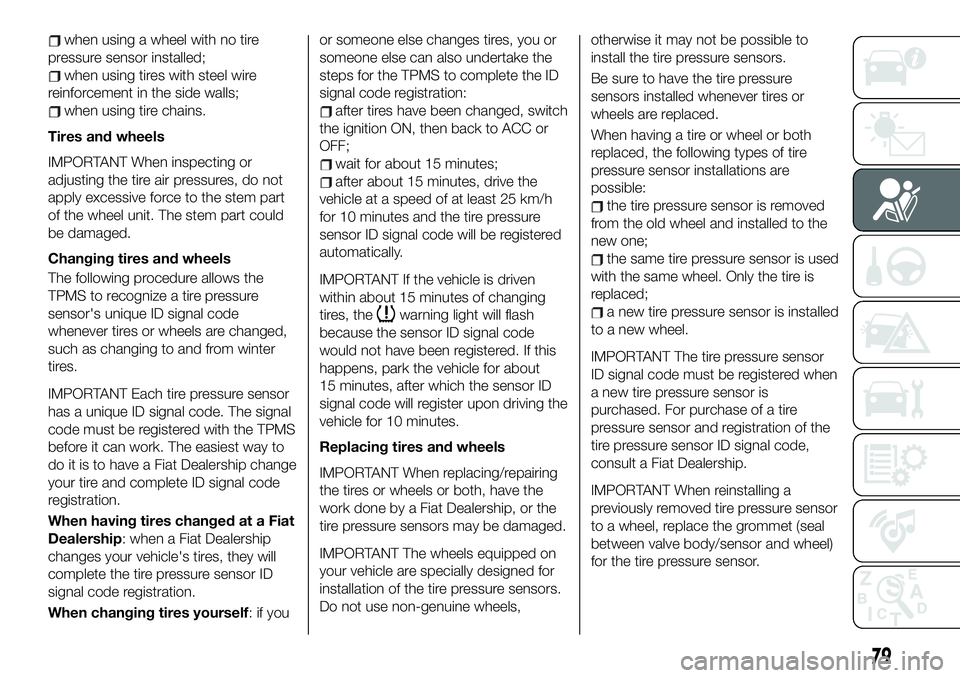
when using a wheel with no tire
pressure sensor installed;
when using tires with steel wire
reinforcement in the side walls;
when using tire chains.
Tires and wheels
IMPORTANT When inspecting or
adjusting the tire air pressures, do not
apply excessive force to the stem part
of the wheel unit. The stem part could
be damaged.
Changing tires and wheels
The following procedure allows the
TPMS to recognize a tire pressure
sensor's unique ID signal code
whenever tires or wheels are changed,
such as changing to and from winter
tires.
IMPORTANT Each tire pressure sensor
has a unique ID signal code. The signal
code must be registered with the TPMS
before it can work. The easiest way to
do it is to have a Fiat Dealership change
your tire and complete ID signal code
registration.
When having tires changed at a Fiat
Dealership: when a Fiat Dealership
changes your vehicle's tires, they will
complete the tire pressure sensor ID
signal code registration.
When changing tires yourself:ifyouor someone else changes tires, you or
someone else can also undertake the
steps for the TPMS to complete the ID
signal code registration:
after tires have been changed, switch
the ignition ON, then back to ACC or
OFF;
wait for about 15 minutes;
after about 15 minutes, drive the
vehicle at a speed of at least 25 km/h
for 10 minutes and the tire pressure
sensor ID signal code will be registered
automatically.
IMPORTANT If the vehicle is driven
within about 15 minutes of changing
tires, the
warning light will flash
because the sensor ID signal code
would not have been registered. If this
happens, park the vehicle for about
15 minutes, after which the sensor ID
signal code will register upon driving the
vehicle for 10 minutes.
Replacing tires and wheels
IMPORTANT When replacing/repairing
the tires or wheels or both, have the
work done by a Fiat Dealership, or the
tire pressure sensors may be damaged.
IMPORTANT The wheels equipped on
your vehicle are specially designed for
installation of the tire pressure sensors.
Do not use non-genuine wheels,otherwise it may not be possible to
install the tire pressure sensors.
Be sure to have the tire pressure
sensors installed whenever tires or
wheels are replaced.
When having a tire or wheel or both
replaced, the following types of tire
pressure sensor installations are
possible:
the tire pressure sensor is removed
from the old wheel and installed to the
new one;
the same tire pressure sensor is used
with the same wheel. Only the tire is
replaced;
a new tire pressure sensor is installed
to a new wheel.
IMPORTANT The tire pressure sensor
ID signal code must be registered when
a new tire pressure sensor is
purchased. For purchase of a tire
pressure sensor and registration of the
tire pressure sensor ID signal code,
consult a Fiat Dealership.
IMPORTANT When reinstalling a
previously removed tire pressure sensor
to a wheel, replace the grommet (seal
between valve body/sensor and wheel)
for the tire pressure sensor.
79
Page 82 of 228
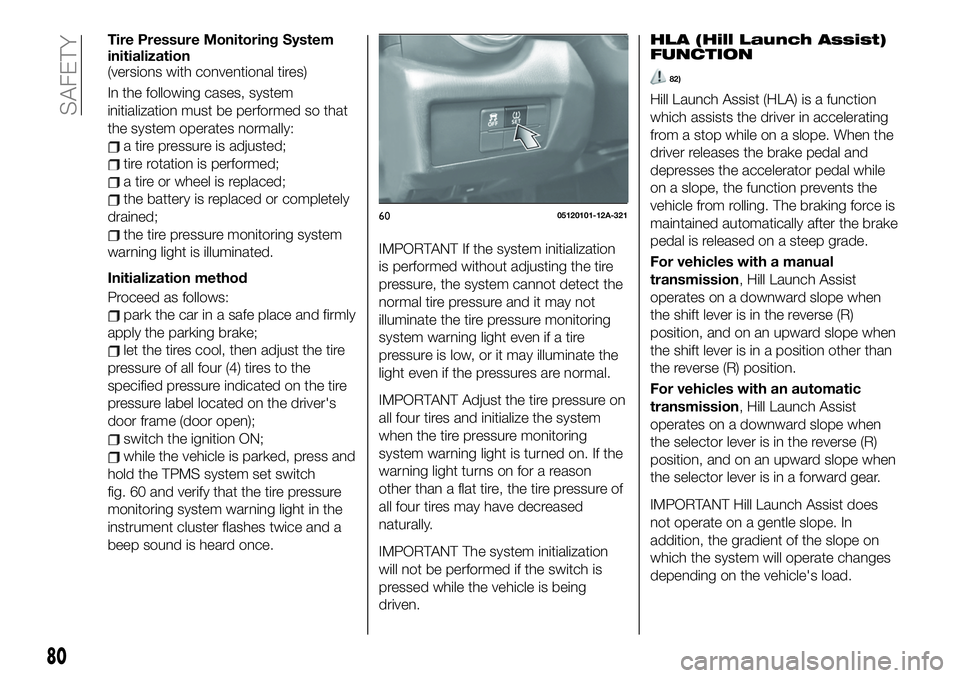
Tire Pressure Monitoring System
initialization
(versions with conventional tires)
In the following cases, system
initialization must be performed so that
the system operates normally:
a tire pressure is adjusted;
tire rotation is performed;
a tire or wheel is replaced;
the battery is replaced or completely
drained;
the tire pressure monitoring system
warning light is illuminated.
Initialization method
Proceed as follows:
park the car in a safe place and firmly
apply the parking brake;
let the tires cool, then adjust the tire
pressure of all four (4) tires to the
specified pressure indicated on the tire
pressure label located on the driver's
door frame (door open);
switch the ignition ON;
while the vehicle is parked, press and
hold the TPMS system set switch
fig. 60 and verify that the tire pressure
monitoring system warning light in the
instrument cluster flashes twice and a
beep sound is heard once.
IMPORTANT If the system initialization
is performed without adjusting the tire
pressure, the system cannot detect the
normal tire pressure and it may not
illuminate the tire pressure monitoring
system warning light even if a tire
pressure is low, or it may illuminate the
light even if the pressures are normal.
IMPORTANT Adjust the tire pressure on
all four tires and initialize the system
when the tire pressure monitoring
system warning light is turned on. If the
warning light turns on for a reason
other than a flat tire, the tire pressure of
all four tires may have decreased
naturally.
IMPORTANT The system initialization
will not be performed if the switch is
pressed while the vehicle is being
driven.HLA (Hill Launch Assist)
FUNCTION
82)
Hill Launch Assist (HLA) is a function
which assists the driver in accelerating
from a stop while on a slope. When the
driver releases the brake pedal and
depresses the accelerator pedal while
on a slope, the function prevents the
vehicle from rolling. The braking force is
maintained automatically after the brake
pedal is released on a steep grade.
For vehicles with a manual
transmission, Hill Launch Assist
operates on a downward slope when
the shift lever is in the reverse (R)
position, and on an upward slope when
the shift lever is in a position other than
the reverse (R) position.
For vehicles with an automatic
transmission, Hill Launch Assist
operates on a downward slope when
the selector lever is in the reverse (R)
position, and on an upward slope when
the selector lever is in a forward gear.
IMPORTANT Hill Launch Assist does
not operate on a gentle slope. In
addition, the gradient of the slope on
which the system will operate changes
depending on the vehicle's load.
6005120101-12A-321
80
SAFETY
Page 83 of 228
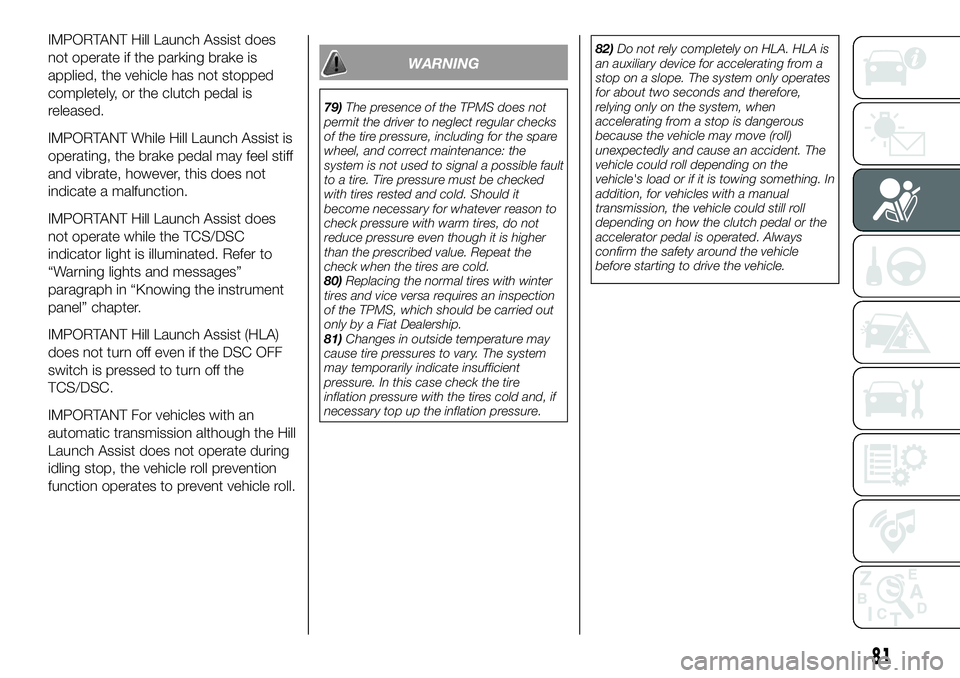
IMPORTANT Hill Launch Assist does
not operate if the parking brake is
applied, the vehicle has not stopped
completely, or the clutch pedal is
released.
IMPORTANT While Hill Launch Assist is
operating, the brake pedal may feel stiff
and vibrate, however, this does not
indicate a malfunction.
IMPORTANT Hill Launch Assist does
not operate while the TCS/DSC
indicator light is illuminated. Refer to
“Warning lights and messages”
paragraph in “Knowing the instrument
panel” chapter.
IMPORTANT Hill Launch Assist (HLA)
does not turn off even if the DSC OFF
switch is pressed to turn off the
TCS/DSC.
IMPORTANT For vehicles with an
automatic transmission although the Hill
Launch Assist does not operate during
idling stop, the vehicle roll prevention
function operates to prevent vehicle roll.
WARNING
79)The presence of the TPMS does not
permit the driver to neglect regular checks
of the tire pressure, including for the spare
wheel, and correct maintenance: the
system is not used to signal a possible fault
to a tire. Tire pressure must be checked
with tires rested and cold. Should it
become necessary for whatever reason to
check pressure with warm tires, do not
reduce pressure even though it is higher
than the prescribed value. Repeat the
check when the tires are cold.
80)Replacing the normal tires with winter
tires and vice versa requires an inspection
of the TPMS, which should be carried out
only by a Fiat Dealership.
81)Changes in outside temperature may
cause tire pressures to vary. The system
may temporarily indicate insufficient
pressure. In this case check the tire
inflation pressure with the tires cold and, if
necessary top up the inflation pressure.82)Do not rely completely on HLA. HLA is
an auxiliary device for accelerating from a
stop on a slope. The system only operates
for about two seconds and therefore,
relying only on the system, when
accelerating from a stop is dangerous
because the vehicle may move (roll)
unexpectedly and cause an accident. The
vehicle could roll depending on the
vehicle's load or if it is towing something. In
addition, for vehicles with a manual
transmission, the vehicle could still roll
depending on how the clutch pedal or the
accelerator pedal is operated. Always
confirm the safety around the vehicle
before starting to drive the vehicle.
81
Page 186 of 228
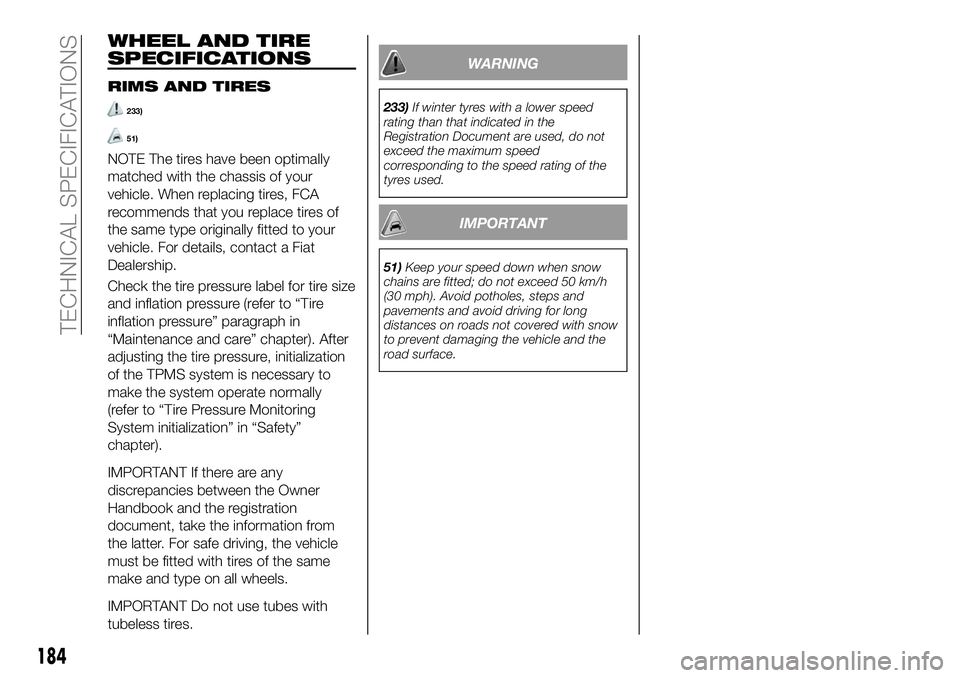
WHEEL AND TIRE
SPECIFICATIONS
RIMS AND TIRES
233)
51)
NOTE The tires have been optimally
matched with the chassis of your
vehicle. When replacing tires, FCA
recommends that you replace tires of
the same type originally fitted to your
vehicle. For details, contact a Fiat
Dealership.
Check the tire pressure label for tire size
and inflation pressure (refer to “Tire
inflation pressure” paragraph in
“Maintenance and care” chapter). After
adjusting the tire pressure, initialization
of the TPMS system is necessary to
make the system operate normally
(refer to “Tire Pressure Monitoring
System initialization” in “Safety”
chapter).
IMPORTANT If there are any
discrepancies between the Owner
Handbook and the registration
document, take the information from
the latter. For safe driving, the vehicle
must be fitted with tires of the same
make and type on all wheels.
IMPORTANT Do not use tubes with
tubeless tires.
WARNING
233)If winter tyres with a lower speed
rating than that indicated in the
Registration Document are used, do not
exceed the maximum speed
corresponding to the speed rating of the
tyres used.
IMPORTANT
51)Keep your speed down when snow
chains are fitted; do not exceed 50 km/h
(30 mph). Avoid potholes, steps and
pavements and avoid driving for long
distances on roads not covered with snow
to prevent damaging the vehicle and the
road surface.
184
TECHNICAL SPECIFICATIONS